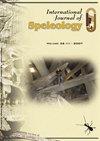4D flow pattern of the longest cave in the Eastern Alps (Schönberg-Höhlensystem, Totes Gebirge)
IF 1.3
4区 地球科学
Q3 GEOSCIENCES, MULTIDISCIPLINARY
引用次数: 0
Abstract
The Schönberg-Höhlensystem (SBH) is not only the longest cave system in the Eastern Alps (length 156 km, depth 1061 m), but a significant proportion of the passages have developed on or just below two surfaces that dip 1.7° to the NE. These so-called "speleogenetic phases" are rarely developed in caves of the Northern Calcareous Alps and have not yet been confirmed by detailed morphological mapping. Furthermore, the deep parts of the cave offer the possibility to study the active epiphreatic zone for a distance of 1.6 km. Detailed morphological mapping shows that the main level at about 1500 m a.s.l. and a second 140 m higher developed as distinct speleogenetic phases, and the dip of the planes to the NE is consistent with palaeo-flow. Isolated vadose trenches formed at saddle points are further evidence. Correlations with other caves at similar altitudes suggest an Upper Miocene to Lower Pliocene age. With few exceptions, a northeastern palaeo-flow can be observed down to about 1050 m a.s.l. However, 100 m above this there appears to have been a late phase with an opposite palaeo-flow direction, and below this altitude this SW palaeo-flow direction prevails. These morphological observations allow us to propose a complex model. During low and moderate flow there is drainage to the north. During floods, a restriction in the north causes backwater and an overflow threshold to the SW is exceeded, and then most of the water flows in this direction. This observation of dual flow behaviour can help to better understand the behaviour of the karst water table and to interpret complex results from tracer experiments. The almost ubiquitous paragenetic features in the SBH are due to sediments derived from the local Upper Jurassic Radiolarite Group. For the evolution of karst plateaus in the Northern Calcareous Alps, these observations support a local and rather radial palaeo-drainage of the Totes Gebirge, as opposed to a through-flow of allogenic waters as is likely for other karst massifs.东阿尔卑斯最长洞穴的4D流动模式(Schönberg-Höhlensystem, Totes Gebirge)
Schönberg-Höhlensystem(SBH)不仅是东阿尔卑斯山最长的洞穴系统(长156公里,深1061米),而且相当大一部分通道发育在向东北倾斜1.7°的两个表面上或正下方。这些所谓的“洞穴成因阶段”在北钙质阿尔卑斯山脉的洞穴中很少发育,也尚未通过详细的形态测绘得到证实。此外,洞穴的深处为研究1.6公里外的活动超临界带提供了可能性。详细的形态图显示,大约1500 m a.s.l.和第二个140 m高的主水位发育为不同的洞穴成因相,平面向东北方向的倾斜与古水流相一致。鞍点形成的孤立包气沟是进一步的证据。与海拔相似的其他洞穴的相关性表明,其时代为上中新世至下上新世。除了少数例外,可以观察到东北部古水流,其深度约为1050 m a.s.l。然而,在该高度以上100 m处,似乎存在一个具有相反古水流方向的晚期,而在该高度以下,则以西南部古水流方向为主。这些形态学观察结果使我们能够提出一个复杂的模型。在低流量和中等流量期间,向北有排水。在洪水期间,北部的限制会导致回水,并超过西南部的溢流阈值,然后大部分水朝着这个方向流动。对双流行为的观察有助于更好地了解岩溶地下水位的行为,并解释示踪剂实验的复杂结果。SBH中几乎无处不在的共生特征是由于来自当地上侏罗纪放射性物质群的沉积物。对于钙质阿尔卑斯山北部岩溶高原的演化,这些观测结果支持了Totes Gebirge的局部且相当放射状的古排水,而不是其他岩溶地块可能存在的同种水的贯通流。
本文章由计算机程序翻译,如有差异,请以英文原文为准。
求助全文
约1分钟内获得全文
求助全文
来源期刊

International Journal of Speleology
地学-地球科学综合
CiteScore
3.10
自引率
23.10%
发文量
12
审稿时长
>12 weeks
期刊介绍:
The International Journal of Speleology has the aim to get cave and karst science known to an increasing number of scientists and scholars. The journal therefore offers the opportunity to all scientists working in and on karst to publish their original research articles or their review papers in an open access, high quality peer reviewed scientific journal at no cost. The journal offers the authors online first, open access, a free PDF of their article, and a wide range of abstracting and indexing services.
 求助内容:
求助内容: 应助结果提醒方式:
应助结果提醒方式:


